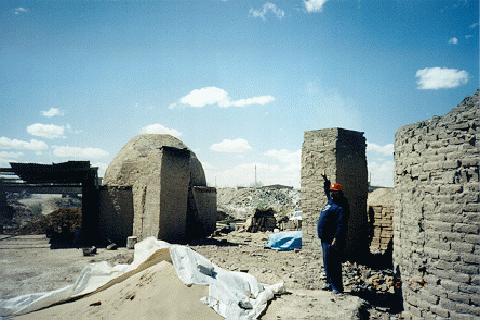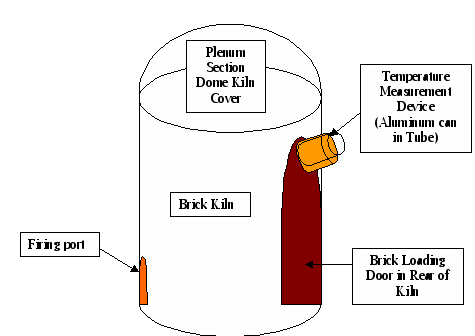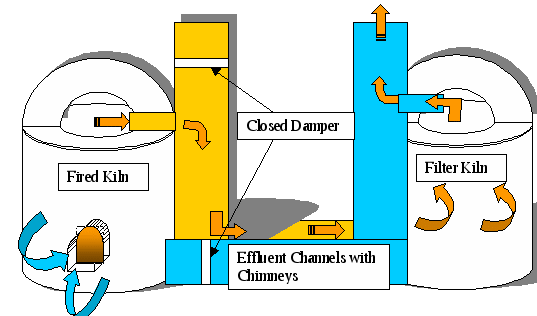![]()
|
|
A
Comparison of the Conventional Kiln with the MK Design
Robert
O. Marquez, Ph.D.
Applied Sciences Laboratory, Inc.
The MK design is an enhancement of existing typical kilns in the Cd. Juarez, Chihuahua, Mexico region (see Figures 1 and 2). It can be fired with the same fuels and firing techniques as the typical kilns of the region. The performance improvement of the MK design over the conventional kiln is due to two main effects. The first is better control of combustion due to higher temperatures in the kiln and controlled airflow through the kiln. The second, is clay filtration of the effluent through unfired brick product where the effluent heat and energy is recycled.

Figure 1. Firing of a Conventional Kiln in Cd. Juarez, Chihuahua, Mexico.
The MK design obtains better control of combustion than a conventional kiln by having a sealed roof design with a defined plenum section and controlled airflow. The sealed roof prevents uncontrolled heat loss to the surrounding environment and hence retains as much energy as is possible in the fired kiln to serve as means to increase temperatures within the kiln as well as distribute the heat more uniformly. A carefully placed opening in the kiln roof section (exit port) allows the controlled release of gaseous effluent and water vapor while maintaining proper airflow through the kiln to maintain combustion. The plenum section, which is an integral part of the roof design, is to prevent water condensation on the roof. The plenum section is a hot air staging area that has an exit port where the hot gases exit the kiln. In order to have a natural draft through the kiln and a fresh supply of oxygen (at the firing port) for combustion, a chimney is attached to the plenum section at the exit port. The design of the roof, plenum section, effluent exit port, chimney and the firing port have been optimized for the best control of natural firing conditions where no external power (fans, blowers, etc.) sources are required to maintain a proper fire in the MK.

Figure 2. Firing of an MK in Cd. Juarez, Chihuahua, Mexico.
The MK is designed to be fired with fuels and techniques as the conventional kilns with the exception of temperature monitoring and control. The conventional kiln requires that at least one person climb on top of the hot kiln and place a cover on the kiln in the areas that have been fired. The person, while covering the fired areas of the kiln, determines the overall progress of the firing and then makes a decision as to when the firing is complete. The MK does not require a person to climb onto the hot kiln; hence, one very dangerous task is eliminated. The MK uses a temperature measurement device to determine when the kiln firing is finished. It is a one-meter section of pipe (steel or clay) that is temporarily sealed on one end with mud. The dried mud serves as a seal and a rest for aluminum cans that are placed into the open end of the pipe after the pipe is placed at an inclined angle (sealed side down) into the kiln. The open-end exits the wall of the kiln at the location where it has been determined that the temperatures of the kiln are the last to reach 600º Celsius (at the top of the kiln loading door). The aluminum cans will melt into the pipe at temperatures greater than 660º Celsius and signal the end of the firing process (see attached Figure 3). Bricks need to reach a minimum of 600º Celsius for them to be considered “good quality” bricks and any temperature higher than that will only make them better. Temperatures higher than 1000º Celsius cause the bricks to change color and hence are sometimes not as saleable as the typical brick products. So the range for acceptable brick product is 600 to 1000º Celsius. Temperatures higher than 600º Celsius only ensure margin in firing completeness but the expense is in fuel consumption and firing time. 660º Celsius is a good compromise and hence a good temperature target to strive for.

Figure 3. Placement of Temperature Measurement Device (TMD)
The second main feature of the MK design that improves operation efficiency of kiln firing is clay filtration. The clay filtration is accomplished by using raw unfired bricks in a second kiln to act as a filter for the hot effluent from the first kiln, the one being fired (see Figure 4). The raw bricks in the second kiln are dried in the process of passing the hot effluent through them. The removal of water from bricks is a large fuel expense (greater than 30% energy consumption) in the brick firing process and hence using the waste heat from the hot effluent will at least save this amount of energy. The effluent from the first kiln contains soot, which is a product of incomplete combustion. The soot is trapped by the raw unfired bricks and serves as fuel during a subsequent re-firing. Once the bricks in the first kiln are fired, cooled, and removed from it new raw bricks are loaded into the first kiln. After the raw bricks are loaded into the first kiln, the second kiln becomes the fired kiln and the first kiln becomes the filter kiln as the process is reversed.
The list below shows the advantages of the MK design over the conventional kiln for a 10,000 brick size production lot:
80% pollution reduction (minimum)
50% fuel reduction (minimum)
30% firing time reduction (minimum)
one dangerous job eliminated (covering a hot kiln)
one less person needed for kiln firing (covering hot kiln)
firing under various climatic conditions (can fire kiln in rain or snow conditions)
second kiln acts as storage and product insurance (10,000 brick protection)
less handling of bricks during processing (stacking and kiln loading).

Figure 4. MK Design and Filtration Concept
The disadvantage of the MK design is in the additional costs of a second kiln, kiln roof, chimneys, and connecting tunnel with dampers. This disadvantage is easily overcome by the fuel and operational savings gained by the new design.